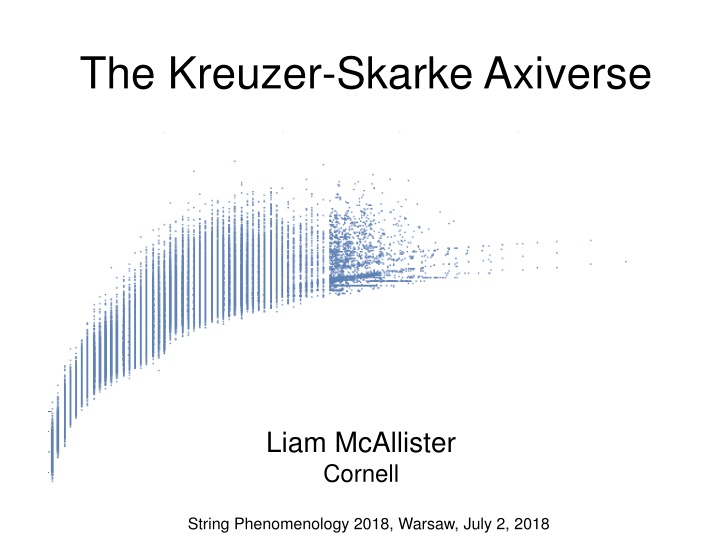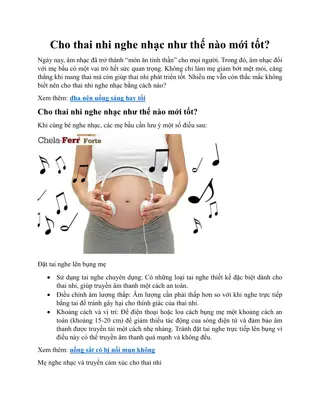The Kreuzer-Skarke Axiverse
In this research, the focus is on exploring ensembles of explicit compactifications of string theory to refine or support conjectures about de Sitter solutions, field ranges, and more. By generating a large ensemble of 4d effective quantum gravity theories through the analysis of Kreuzer-Skarke subsets, new statistical models and mechanisms for moduli stabilization could be discovered. Through triangulation and topological data analysis, the landscape of Calabi-Yau hypersurfaces is being scrutinized for insights into quantum gravity.
Download Presentation

Please find below an Image/Link to download the presentation.
The content on the website is provided AS IS for your information and personal use only. It may not be sold, licensed, or shared on other websites without obtaining consent from the author.If you encounter any issues during the download, it is possible that the publisher has removed the file from their server.
You are allowed to download the files provided on this website for personal or commercial use, subject to the condition that they are used lawfully. All files are the property of their respective owners.
The content on the website is provided AS IS for your information and personal use only. It may not be sold, licensed, or shared on other websites without obtaining consent from the author.
E N D
Presentation Transcript
The Kreuzer-Skarke Axiverse Liam McAllister Cornell String Phenomenology 2018, Warsaw, July 2, 2018
Based on: Mehmet Demirtas, Cody Long, L.M., and Mike Stillman, The Kreuzer-Skarke Axiverse, to appear. See also: Talk by Demirtas in parallel session Braun, Long, L.M., Stillman, Sung, The Hodge Numbers of Divisors of Calabi-Yau Hypersurfaces, 1712.04946 Long, L.M., Stout, Systematics of Axion Inflation in Calabi-Yau Hypersurfaces, 1603.01259 Long, L.M., McGuirk, Heavy Tails in Calabi-Yau Moduli Spaces , 1407.0709
Main idea We explore the landscape of CY3 hypersurfaces at large . We can now triangulate and obtain topological data of CY3 anywhere in the Kreuzer-Skarke list, in seconds per geometry. At large we find narrow K hler cones, large volumes, ultralight axions, and small field ranges.
Plan 1. Motivation 2. Computation: Kreuzer-Skarke at large 3. Results: large volumes, ultralight axions 4. Outlook
Motivation To learn about quantum gravity, can study ensembles of explicit compactifications of string theory. Use to refine, refute, or support no-go conjectures about de Sitter solutions, super-Planckian field ranges, etc. Complementary to broad-brush landscape statistics suggests new statistical models Can inform questions that hinge on topological data e.g., axion alignment from special axion charges of instantons May find new mechanisms for moduli stabilization and reveal relative prevalence of known mechanisms Do not know what we will find, so we should look!
Motivation How can we generate and characterize a large ensemble of explicit solutions? Setting: type IIB orientifold compactifications on Calabi- Yau threefolds. Take CY3 hypersurfaces X in 4d toric varieties V. Such V correspond to triangulations of 4d reflexive polytopes, all 473,800,776 of which Kreuzer and Skarke have enumerated.
Goal Generate and study a large ensemble of 4d effective quantum gravity theories by analyzing (subsets of) KS. Requires adaptations of existing packages, as well as new algorithms and new mathematical results. Realistically, begin with separate studies of different aspects of EFT (e.g., instantons, kinetic terms, D-brane configurations), but hope to merge someday. What can we do to build such an ensemble?
Computational task 1. Triangulate polytope 2. Examine fine regular star triangulation to obtain a. Toric variety V, Mori cone of V. b. Intersection numbers of . A. Braun Oda, Park; Berglund, Katz, Klemm This gives the metric on K hler moduli space, at leading order in and . Witten cf. scenarios: Kachru, Kallosh, Linde, Trivedi Balasubramanian, Berglund, Conlon, Quevedo Bobkov, Braun, Kumar, Raby To compute ED3 superpotential, need topological data of divisors D of X. Blumenhagen, Jurke, Rahn, Roschy Bies, Mayrhofer, Weigand Braun, Long, L.M., Stillman, Sung
Computational task 1. Triangulate polytope 2. Examine fine regular star triangulation to obtain a. Toric variety V, Mori cone of V. b. Intersection numbers of . A. Braun Oda, Park; Berglund, Katz, Klemm Number of relevant points = . ( favorable case) Number of intersection numbers ~ Number of triangulations/polytope grows exponentially.
hardest accessible now cf. Huang and Taylor h1,1 many, systematic few, limited h2,1 Altman, He, Gray, Jejjala, Nelson Cicoli, Ciupke, Mayrhofer, Shukla Altman, He, Jejjala, Nelson Braun, Lukas, Sun Long, L.M., McGuirk Taylor, Wang Gao, Shukla Cicoli, Krippendorf, Mayrhofer, Quevedo, Valandro + many more 473,800,776 4d polytopes easiest
Computational task 1. Triangulate polytope 2. Examine triangulation to obtain a. Mori cone of V b. Intersection numbers of X Used and . FRST method: A. Braun Intersection numbers in : 1 CY3 at in 30 min New intersection number algorithm: 1 CY3 at in 30 sec All 653,057 CY3 with in 1 day 1 FRST/ for in 2 hr
Strategy: go big Enumerating geometries anywhere in KS is feasible. Obtaining all distinct geometries is not. Idea: develop statistical models of particularly interesting properties of EFTs. Obtain these by enumerating millions of geometries at . Find empirical scaling laws with . Use as small parameter in model (e.g., RMT). Aim: understand broad properties of EFTs in bulk of KS, before a purely mechanical ingestion of all of KS. Possible that most vacua are in this realm. Long, L.M., McGuirk Bachlechner, Dias, Frazer, L.M. Bachlechner, Long, L.M. Long, L.M., Stout Heidenreich, Long, L.M., Reece, Rudelius, Stout cf. fourfold case: Taylor, Wang cf. String Axiverse, Arvanitaki et al.
Random matrix theory = Supergravity Hessian: Wigner+Wishart+Wishart Marsh, L.M., Wrase Alignment from eigenvector delocalization Heavy tails in Calabi-Yau spectra Long, L.M., McGuirk Bachlechner, Dias, Frazer, L.M.
Limitation: Weak Coupling Topological data contained in KS determines (many aspects of) EFT only in the regime of weak coupling and large volume. Hope to learn about EFTs beyond this regime of perturbative control, but we have to start somewhere. This talk: implications of requiring control of curvature expansion.
Khler and Mori cones K hler cone: = set of cohomology classes of K hler forms. Mori cone: = cone of effective curves. i.e. classes realized by 1d subvarieties. are dual cones: generators of Stretched K hler cone:
Stretched Khler cone Mori cone generator K hler cone generator
Stretched Khler cone Logic: hard to compute perturbative corrections as functions of moduli. But when an effective curve is small, can have unsuppressed WSI. So use as a proxy for control of expansion.
Key observation When , the condition implies that some curves and divisors are very large. 1. What is the origin of this phenomenon? 2. How large is the effect, in real Calabi-Yau threefolds? 3. What are its consequences?
Key observation Suppose: Solution:
Stretched Khler cone Mori cone generator K hler cone generator
Example Prime toric divisor volumes:
Approximating the cones For a CY3 hypersurface , we cannot actually compute K hler cone of X when . Can compute ; it is often assumed that this is a good approximation to Can also compute cone generated by curves of the form Knapp and Kreuzer Call this cone .
Approximating the cones cf. Cicoli, Ciupke, Mayrhofer, Shukla
Results: Narrow cones, which beget large cycles
Ultralight axion caveats Holds in region of control of curvature expansion. If all divisors are large, all ED3 wrapping divisors give small terms in superpotential. What about axion masses from ED3 wrapping non- holomorphic cycles? That is a whole talk. Bottom line: not known, quite interesting.
Axion fundamental domain is small in the most-restrictive region
but can be large in the least-restrictive region
Implications PICK ONE: corrections, massless axions, small . Stabilization by nonperturbative effects appears difficult at large , even if we could choose which divisors are rigid. Many couplings controlled by . Can search our data for outliers with anomalously small volume, and Planckian axion decay constants. cf. Douglas Denef Florea Grassi Kachru Dimopoulos Kachru McGreevy Wacker Rudelius Bachlechner, Long, L.M.
Cosmological constraints Kreuzer-Skarke axiverse contains many axions, some massless, with small periodicities. Possible constraints from couplings to SM (helioscope, holoscope, red giants, supernovae, CMB, X-rays) But first have to specify realization of SM! Possible constraints from moduli decays to dark radiation, or from overproduction of axion DM. But first have to specify (non-)thermal history. Possible constraints from black hole superradiance. Dedicated analysis required, worthwhile. Could impact/inspire axion inflation model-building. Sikivie M.C.D. Marsh et al. Cicoli, Conlon, Quevedo Higaki, Takahashi Arvanitaki et al. Stott and D.J.E. Marsh cf. Physics Reports by D.J.E. Marsh
Conclusions Constructed and studied a landscape of CY3 hypersurfaces: 2 million CY3 with . including one FRST of each polytope with . This is a step toward the goal of constructing a large ensemble of solutions of string theory, by stabilizing moduli in these geometries. Can use to test ideas about quantum gravity EFTs. When curvature expansion is under control, many cycles are very large, with , and some axions are massless.
Outlook In a few months on a cluster, could get one CY3 for each of the 473,776,800 polytopes in KS list. Number of triangulations per polytope not known, but likely vast for . What is generic in the KS ensemble? Could estimate , and weight polytopes by this factor. Obtaining raw topological data (intersection numbers, Mori cone of V) was the first step. Manipulating this data to stabilize moduli and study vacua will be challenging at . Extracting physical lessons from this dataset is a natural target for machine learning.
Non-holomorphic instantons We ve shown that requiring that no holomorphic curve is small implies that some holomorphic curves and divisors are large. Corresponding instantons in W are highly suppressed. Are K hler potential instantons correspondingly suppressed? i.e., are non-holomorphic instanton contributions under control whenever one is well inside the K hler cone? Not asking that they be negligible, just not parametrically larger than instantons in W.
Minimal volumes Suppose X is a compact K hler manifold, and If is a holomorphic representative, it is calibrated by J, and absolutely volume minimizing in its class. Specifying a point inside the K hler cone determines the size of corresponding superpotential term. What if has no holomorphic representative? (e.g., classes outside the cones of effective curves or effective divisors). Can we constrain the size of contributions from D-brane instantons wrapping ?
Toy example Suppose with volumes generate the cone of effective divisors. Take W cannot contain terms But can there be terms ? General question: given a point in the K hler cone, can we lower-bound the actions of D-brane instantons wrapping classes outside the effective cone?
Minimal volumes Question: let X be a compact K hler manifold, and consider such that has no holomorphic representative. Denote by the volume of the minimum-volume representative of bound on ? . Is there a lower
Plateaus problem Given a smooth curve , what is the least-area surface with boundary ? Minimizing within the class of smooth submanifolds does not always converge to a limit within this class. i.e., singular configurations can have smaller volume than any smooth submanifold.
Plateaus problem Given a smooth curve , what is the least-area surface with boundary ? Minimizing within the class of smooth submanifolds does not always converge to a limit within this class. i.e., singular configurations can have smaller volume than any smooth submanifold. Federer and Fleming (1960): defined integral currents Formal sums of submanifolds except for measure-0 singularities.
Geometric measure theory Defines minimization of area in class of integral currents. Fundamental theorem: a minimizer always exists! Singularities have codimension at least 2! (Almgren) Holomorphic chain: formal sum with irreducible subvarieties. Positive holomorphic chain: Positive holomorphic chains minimize area. Is a general minimizer a general holomorphic chain?
Are minimizers holomorphic? Suppose X is a compact CY, and are effective. Minimizers for are holomorphic curves , with volumes . Q: is minimizer of given by ? In this case, . A: (Micallef and Wolfson, 2005) No. In a K3 orbifold, they exhibit a volume-minimizer with Holomorphic and antiholomorphic curves fuse and recombine to reduce their energy (volume).





















